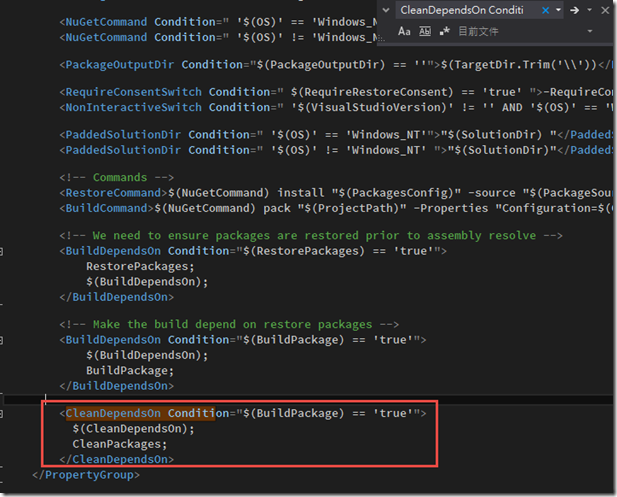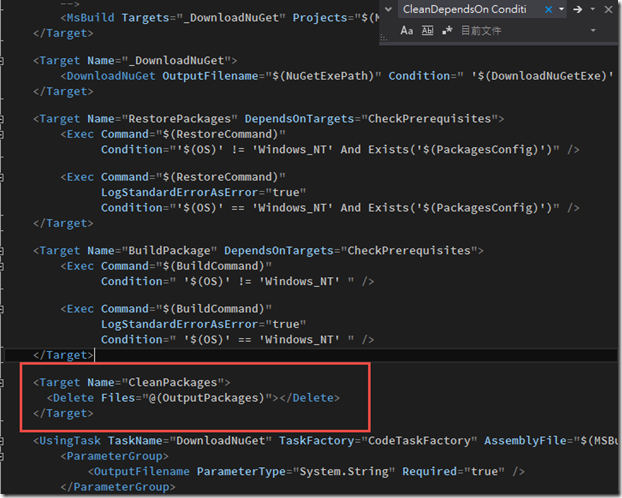延續前一篇,這篇要談的是一個小小的不方便與問題,畢竟人類的懶惰是沒有極限的。
如果大家有測是下來,可能就會發現如下圖的問題,是的,產生了非常多的nupkg檔案…畢竟每次增加一個版本,就會多兩個nupkg檔案如下圖;當然如果一開始少少的可能還好,但越來越多的時候,就會感覺很髒亂…,所以這篇,我們就來看看如何建立的過程中,順便移除舊版的Package。
那要怎麼做呢??,其實每次建立的時候,都是透過NuGet.targets來觸發動作,所以我們要增加一些小東西到NuGet.targets裡面去。
首先,我們要先在前面填入以下的Code,這邊我們定義了OutputPackages的內容,是nupkg的路徑。
<ItemGroup>
<OutputPackages Include="$(TargetDir)*.nupkg" />
</ItemGroup>
將此Code放到下圖的位置。
接下來,我們要定義一個CleanDependsOn的標籤,當條件成立的時候,就會執行此標籤裡面的內容。
<CleanDependsOn Condition="$(BuildPackage) == 'true'"> $(CleanDependsOn); CleanPackages; </CleanDependsOn>
我們要把此標籤放到底下的位置。
最後,這個內容到底要做甚麼事情哩,就是最後面這個標籤的內容了,也就是Delete Files,要刪除的檔案,就是我們一開始定義的路徑。
<Target Name="CleanPackages"> <Delete Files="@(OutputPackages)"></Delete> </Target>
我們把此標籤放到以下的位置。
完成之後,我們要使用重建的動作,如果只用建置,是沒辦法觸發的。
重建之後,我們就可以發現,原本的nupkg檔案全部都被砍掉了,只留下最新版喔!!
最後的最後,附上完整的NuGet.targets xml給大家參考~
<?xml version="1.0" encoding="utf-8"?>
<Project ToolsVersion="4.0" xmlns="http://schemas.microsoft.com/developer/msbuild/2003">
<ItemGroup>
<OutputPackages Include="$(TargetDir)*.nupkg" />
</ItemGroup>
<PropertyGroup>
<SolutionDir Condition="$(SolutionDir) == '' Or $(SolutionDir) == '*Undefined*'">$(MSBuildProjectDirectory)\..\</SolutionDir>
<!-- Enable the restore command to run before builds -->
<RestorePackages Condition="'$(RestorePackages)' == ''">false</RestorePackages>
<!-- Property that enables building a package from a project -->
<BuildPackage Condition="'$(BuildPackage)' == ''">false</BuildPackage>
<!-- Determines if package restore consent is required to restore packages -->
<RequireRestoreConsent Condition="'$(RequireRestoreConsent)' != 'false'">true</RequireRestoreConsent>
<!-- Download NuGet.exe if it does not already exist -->
<DownloadNuGetExe Condition="'$(DownloadNuGetExe)' == ''">false</DownloadNuGetExe>
</PropertyGroup>
<ItemGroup Condition="'$(PackageSources)' == ''">
<!-- Package sources used to restore packages. By default, registered sources under %APPDATA%\NuGet\NuGet.Config will be used -->
<!-- The official NuGet package source (https://www.nuget.org/api/v2/) will be excluded if package sources are specified and it does not appear in the list -->
<!--
<PackageSource Include="https://www.nuget.org/api/v2/" />
<PackageSource Include="https://my-nuget-source/nuget/" />
-->
</ItemGroup>
<PropertyGroup Condition="'$(OS)' == 'Windows_NT'">
<!-- Windows specific commands -->
<NuGetToolsPath>$([System.IO.Path]::Combine($(SolutionDir), ".nuget"))</NuGetToolsPath>
</PropertyGroup>
<PropertyGroup Condition="'$(OS)' != 'Windows_NT'">
<!-- We need to launch nuget.exe with the mono command if we're not on windows -->
<NuGetToolsPath>$(SolutionDir).nuget</NuGetToolsPath>
</PropertyGroup>
<PropertyGroup>
<PackagesProjectConfig Condition="'$(OS)' == 'Windows_NT'">$(MSBuildProjectDirectory)\packages.$(MSBuildProjectName.Replace('', '_')).config</PackagesProjectConfig>
<PackagesProjectConfig Condition="'$(OS)' != 'Windows_NT'">$(MSBuildProjectDirectory)\packages.$(MSBuildProjectName).config</PackagesProjectConfig>
</PropertyGroup>
<PropertyGroup>
<PackagesConfig Condition="Exists('$(MSBuildProjectDirectory)\packages.config')">$(MSBuildProjectDirectory)\packages.config</PackagesConfig>
<PackagesConfig Condition="Exists('$(PackagesProjectConfig)')">$(PackagesProjectConfig)</PackagesConfig>
</PropertyGroup>
<PropertyGroup>
<!-- NuGet command -->
<NuGetExePath Condition="'$(NuGetExePath)' == ''">$(NuGetToolsPath)\NuGet.exe</NuGetExePath>
<PackageSources Condition=" $(PackageSources) == ''">@(PackageSource)</PackageSources>
<NuGetCommand Condition="'$(OS)' == 'Windows_NT'">"$(NuGetExePath)"</NuGetCommand>
<NuGetCommand Condition="'$(OS)' != 'Windows_NT'">mono --runtime=v4.0.30319 "$(NuGetExePath)"</NuGetCommand>
<PackageOutputDir Condition="$(PackageOutputDir) == ''">$(TargetDir.Trim('\\'))</PackageOutputDir>
<RequireConsentSwitch Condition=" $(RequireRestoreConsent) == 'true'">-RequireConsent</RequireConsentSwitch>
<NonInteractiveSwitch Condition="'$(VisualStudioVersion)' != '' AND '$(OS)' == 'Windows_NT'">-NonInteractive</NonInteractiveSwitch>
<PaddedSolutionDir Condition="'$(OS)' == 'Windows_NT'">"$(SolutionDir) "</PaddedSolutionDir>
<PaddedSolutionDir Condition="'$(OS)' != 'Windows_NT'">"$(SolutionDir)"</PaddedSolutionDir>
<!-- Commands -->
<RestoreCommand>$(NuGetCommand) install "$(PackagesConfig)" -source "$(PackageSources)" $(NonInteractiveSwitch) $(RequireConsentSwitch) -solutionDir $(PaddedSolutionDir)</RestoreCommand>
<BuildCommand>$(NuGetCommand) pack "$(ProjectPath)" -Properties "Configuration=$(Configuration);Platform=$(Platform)" $(NonInteractiveSwitch) -OutputDirectory "$(PackageOutputDir)" -symbols</BuildCommand>
<!-- We need to ensure packages are restored prior to assembly resolve -->
<BuildDependsOn Condition="$(RestorePackages) == 'true'">
RestorePackages;
$(BuildDependsOn);
</BuildDependsOn>
<!-- Make the build depend on restore packages -->
<BuildDependsOn Condition="$(BuildPackage) == 'true'">
$(BuildDependsOn);
BuildPackage;
</BuildDependsOn>
<CleanDependsOn Condition="$(BuildPackage) == 'true'">
$(CleanDependsOn);
CleanPackages;
</CleanDependsOn>
</PropertyGroup>
<Target Name="CheckPrerequisites">
<!-- Raise an error if we're unable to locate nuget.exe -->
<Error Condition="'$(DownloadNuGetExe)' != 'true' AND !Exists('$(NuGetExePath)')" Text="Unable to locate '$(NuGetExePath)'" />
<!--
Take advantage of MsBuild's build dependency tracking to make sure that we only ever download nuget.exe once.
This effectively acts as a lock that makes sure that the download operation will only happen once and all
parallel builds will have to wait for it to complete.
-->
<MsBuild Targets="_DownloadNuGet" Projects="$(MSBuildThisFileFullPath)" Properties="Configuration=NOT_IMPORTANT;DownloadNuGetExe=$(DownloadNuGetExe)" />
</Target>
<Target Name="_DownloadNuGet">
<DownloadNuGet OutputFilename="$(NuGetExePath)" Condition="'$(DownloadNuGetExe)' == 'true' AND !Exists('$(NuGetExePath)')" />
</Target>
<Target Name="RestorePackages" DependsOnTargets="CheckPrerequisites">
<Exec Command="$(RestoreCommand)"
Condition="'$(OS)' != 'Windows_NT' And Exists('$(PackagesConfig)')" />
<Exec Command="$(RestoreCommand)"
LogStandardErrorAsError="true"
Condition="'$(OS)' == 'Windows_NT' And Exists('$(PackagesConfig)')" />
</Target>
<Target Name="BuildPackage" DependsOnTargets="CheckPrerequisites">
<Exec Command="$(BuildCommand)"
Condition="'$(OS)' != 'Windows_NT'" />
<Exec Command="$(BuildCommand)"
LogStandardErrorAsError="true"
Condition="'$(OS)' == 'Windows_NT'" />
</Target>
<Target Name="CleanPackages">
<Delete Files="@(OutputPackages)"></Delete>
</Target>
<UsingTask TaskName="DownloadNuGet" TaskFactory="CodeTaskFactory" AssemblyFile="$(MSBuildToolsPath)\Microsoft.Build.Tasks.v4.0.dll">
<ParameterGroup>
<OutputFilename ParameterType="System.String" Required="true" />
</ParameterGroup>
<Task>
<Reference Include="System.Core" />
<Using Namespace="System" />
<Using Namespace="System.IO" />
<Using Namespace="System.Net" />
<Using Namespace="Microsoft.Build.Framework" />
<Using Namespace="Microsoft.Build.Utilities" />
<Code Type="Fragment" Language="cs">
<![CDATA[
try {
OutputFilename = Path.GetFullPath(OutputFilename);
Log.LogMessage("Downloading latest version of NuGet.exe...");
WebClient webClient = new WebClient();
webClient.DownloadFile("https://www.nuget.org/nuget.exe", OutputFilename);
return true;
}
catch (Exception ex) {
Log.LogErrorFromException(ex);
return false;
}
]]>
</Code>
</Task>
</UsingTask>
</Project>
基本上,到這邊,就完成嚕!!






